


LOUIS XIII OF FRANCE
1610 -
Acknowledgements
Louis XIII:
detail, by the French painter Philippe de Champaigne (1602-
Including:
The Estates
General

xxxxxAs we have seen, Henry IV of France brought the French Religious Wars to an end by the Edict of Nantes in 1598 (L1). But his assassination in May 1610 brought further conflict. His son Louis XIII was only nine at the time, and his mother, Marie de Medici, proved an ineffectual leader, dominated by her Italian favourite Concino Concini. The Estates General was summoned in 1614 in the hope of restoring peace, but disputes broke out, and the meeting was quickly abandoned. As a result, fighting was resumed between the Catholics and Huguenots. Louis eventually gained power in 1617, but then had to face two armed revolts led by his mother. A fragile reconciliation between mother and son was finally achieved by her advisor, the Bishop of Luçon (Armand du Plessis de Richelieu). She returned to court and was influential in having Richelieu appointed chief minister in 1624. He became the power behind the throne for the rest of the reign and, as we shall see (1628 C1), his ruthless policy put the French monarchy well on the way to absolute rule.
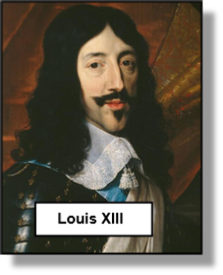 xxxxxAs we have seen, Henry of Navarre, as leader of the
Huguenots, played a major role
during the final stages of the French Religious Wars. Four years
after coming to the throne as Henry IV in 1589, he converted to
the Roman Catholic faith and, after prolonged consultation with
the Huguenots, hammered out a compromise settlement which brought
the religious wars to an end. This understanding, the Edict of
Nantes of 1598 (L1),
was only a truce, but it did at least bring about a lengthy albeit
uneasy period of religious toleration. It was not until Henry was
assassinated by a Catholic extremist in May 1610 that trouble
broke out again, and even then it was not on the same scale as the
previous conflict.
xxxxxAs we have seen, Henry of Navarre, as leader of the
Huguenots, played a major role
during the final stages of the French Religious Wars. Four years
after coming to the throne as Henry IV in 1589, he converted to
the Roman Catholic faith and, after prolonged consultation with
the Huguenots, hammered out a compromise settlement which brought
the religious wars to an end. This understanding, the Edict of
Nantes of 1598 (L1),
was only a truce, but it did at least bring about a lengthy albeit
uneasy period of religious toleration. It was not until Henry was
assassinated by a Catholic extremist in May 1610 that trouble
broke out again, and even then it was not on the same scale as the
previous conflict.
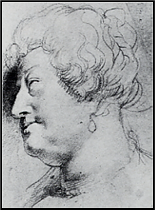
xxxxxHenry'sxson Louis was only nine when his father was murdered.
During his minority his mother, Marie de
Medici (illustrated) acted as regent and proved an ineffectual leader.
Dominated by her Italian favourite, Concino Concini, she reversed
Henry's anti-
xxxxxWhen Louis
XIII reached the age of 14, his mother refused to give up the
reins of government. He eventually gained power in 1617 by having
Concini murdered and his mother exiled to Blois, but in 1619 and
1620 he had to suppress two further armed rebellions by her, aimed
at regaining control of the country. Later, through the good
offices of her advisor, the up-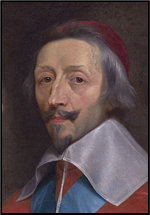 to
return to court where she became instrumental in furthering
Richelieu's career. It was mainly due to her influence that he was
made a Cardinal in 1622, and appointed the king's chief minister
in
to
return to court where she became instrumental in furthering
Richelieu's career. It was mainly due to her influence that he was
made a Cardinal in 1622, and appointed the king's chief minister
in
xxxxxAs we shall
see (1628 C1), the appointment of
Richelieu as chief minister was to have far-
xxxxxIncidentally, the famous Flemish artist Rubens chronicled the life of Marie de Medici in 21 large paintings. The portrait above was one of the sketches made to assist him in this huge task.
J1-
xxxxxQuite apart from the rise of Richelieu, the reign of Louis XIII was important in respect of the Estates General, the French parliament. This had first been summoned in 1302, and was then made up of the three “estates”, the nobility, the clergy and the commoners. In fact, however, it had developed little over the years, and soon after it was summoned in 1614, during the turbulent years of Louis’ minority, disputes broke out between the three estates and the meeting was abandoned. Its next and last meeting was not until 1789 on the eve of the French Revolution.
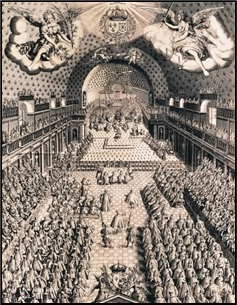 xxxxxAnd the reign of Louis XIII was also significant
regarding the fate of the Estates
General, the French parliament. This had
first been summoned in 1302 and was made up of members from three
"Estates" -
xxxxxAnd the reign of Louis XIII was also significant
regarding the fate of the Estates
General, the French parliament. This had
first been summoned in 1302 and was made up of members from three
"Estates" -
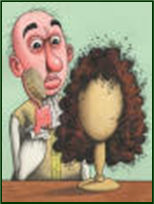
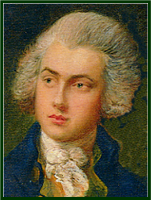 xxxxxIncidentally, the
popularity of the peruke or periwig
is all down to Louis XIII. He began wearing one in 1624 to conceal
his baldness, and from then on it became an accepted form of dress
for men -
xxxxxIncidentally, the
popularity of the peruke or periwig
is all down to Louis XIII. He began wearing one in 1624 to conceal
his baldness, and from then on it became an accepted form of dress
for men -
xxxxxBut wigs
were around long before the 17th century. The Ancient Egyptians
used to shave their heads and then wear wigs as a protection
against the sun -


